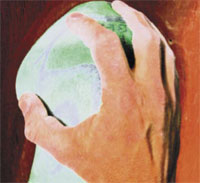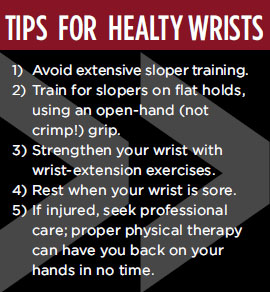The Big Squeeze
NAVIGATING THE SLIPPERY SLOPE OF WRIST HEALTH
Click here to download the pdf
 THE WRIST, INNOCUOUSLY situated between your hand and elbow, home to eight carpal bones and a web of ligaments and tendons, is a Pandora’s box of injuries: cysts, ganglions, repetitive strain injuries (of many painful flavors),fractures, arthritides, ligament and tendon strains, nerve-compression syndromes—the list goes on. At some point, however, all these ouchies boil down to a simple “Nuts, my wrist hurts!” (or something more explicit) during many climbing careers. The most common wrist injury sustained by climbers is damage to “the disc,” a useful and descriptive abbreviation of the long-winded Triangular Fibrocartilage Complex. The disc is a small plate of cartilage suspended by ligaments between the end of your ulna(the forearm bone on the little-finger side of your arm) and the carpal bones of your wrist. The disc, traditionally injured by andro-fiends (aka professional baseball players) sliding hands-first into home plate, is being injured by climbers, especially of the gym variety, who continually pull on poor slopers despite the slow onset of wrist pain.
THE WRIST, INNOCUOUSLY situated between your hand and elbow, home to eight carpal bones and a web of ligaments and tendons, is a Pandora’s box of injuries: cysts, ganglions, repetitive strain injuries (of many painful flavors),fractures, arthritides, ligament and tendon strains, nerve-compression syndromes—the list goes on. At some point, however, all these ouchies boil down to a simple “Nuts, my wrist hurts!” (or something more explicit) during many climbing careers. The most common wrist injury sustained by climbers is damage to “the disc,” a useful and descriptive abbreviation of the long-winded Triangular Fibrocartilage Complex. The disc is a small plate of cartilage suspended by ligaments between the end of your ulna(the forearm bone on the little-finger side of your arm) and the carpal bones of your wrist. The disc, traditionally injured by andro-fiends (aka professional baseball players) sliding hands-first into home plate, is being injured by climbers, especially of the gym variety, who continually pull on poor slopers despite the slow onset of wrist pain.
Fact is, most climbers have a fairly good idea that they are hurting their wrists. Usually, they keep doing it, just to be sure. Unlike many climbing injuries, those involving the wrist’s carpal bones and the matrix of cartilage in between them often have an insidious onset: There are seldom any snap, crackle or pop noises. The predominant symptom is a worsening dull ache, usually on the pinkie-finger side of the wrist, though the pain could resonate throughout the wrist. Sometimes, bending your hand toward your little finger could produce a sharp pain.
There are two ways to hurt the disc: tear it, or its suspensor ligaments, by pulling; or crush it via compression. Climbers typically sustain the former when open-handing big slopers. (The traction and shearing forces placed on the disc are greatest in this position, due to biomechanical factors.)Crimping will cause much less aggravation to the wrist, though this motions notorious for tearing pulley tendons in the fingers and bringing on elbow pain. There are a few things you can do for disc injury. First, let it heal. This is perhaps the hardest to do. You can continue to climb with this injury, but it needs tube done with good advice from a knowledgeable physical therapist, considerable care and an understanding that things may go awry.
 A bit of taping-up, done in the right way (a textbook could be written on this subject), can go a long way to supporting the problem and preventing re-injury. To make sure you are doing it correctly, hire someone who knows how to tape specifically for a disc injury, perhaps your local physical therapist.
A bit of taping-up, done in the right way (a textbook could be written on this subject), can go a long way to supporting the problem and preventing re-injury. To make sure you are doing it correctly, hire someone who knows how to tape specifically for a disc injury, perhaps your local physical therapist.
Exercises to strengthen the wrist extensors are also a good idea. They give the wrist greater stability in the open-hand position. A few sets of wrist-extension exercises—where you rotate the wrist up and down slowly while holding a can of soup or a barbell, meanwhile stabilizing your forearm against your leg or a table —a couple of times a week should suffice.
However, the best medicine is always preventative. If you think your wrist is getting sore, don’t test your theory by continuing to climb. Try not to overdo it on big slopers or macro features during any given session. Build up your sloper strength without actually climbing on slopers by using open-hand grips on flat holds whenever possible. Try to vary the grips you choose when training to maximize your gym time and reduce your chance of injury.
If your wrist is chronically sore, see an expert. A little physical therapy can go a long way toward speeding up the healing process.

